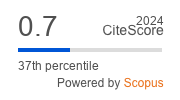Evaluation Aseptic Loosening of Primary Hip Arthroplasty
DOI:
https://doi.org/10.47723/kcmj.v16i1.187Keywords:
aseptic loosening, hip endoprosthesisAbstract
Background : The number of primary hip arthroplasty is growing with every passing year. At present this surgical operation has no equal in the rate of yielding good results. Despite the fact that in many cases in the long term after surgery radiolucent lines around the cup are observed, the clinical outcomes remain satisfactory.
Aim of the study :To study the clinical and radiological manifestations of the aseptic loosening of the endoprosthesis
Methods: This is a prospective study based on an analysis of diagnostic findings of 51 patients with aseptic loosening of hip joint components, aged 30 to 84 years. We depend for diagnosis of a septic losing by both clinical evaluation and X-ray assessment Results:The majority of clinical and radiological evidence of aseptic loosening appear after three years (47%).All our patients had a pain syndrome of varying intensity, with (43.2%) used a walking-stick. Shortening limb from 1 to 7 cm was found in 43 patients 85.2%.
The aseptic losing are common in cementless hip prosthesis especially in femoral stem part of prosthesus 53.9% versus 25.6% in cemented type,
Revision surgery for primary hip prosthesis occur mainly for femoral stem involve 49% while other 25.5% involve both acetabular cup and femoral stem, while the rest of patient(25.5%) involve revision of acetabular cup only. Discussion :At present this surgical operation has no equal in the rate of yielding good results. The lifetime of the majority of artificial joints does not exceed 15 years mainly due to aseptic loosening of one or both endoprosthetic components There are many causes of aseptic instability: substandard surgical technique, unwarranted extension of the indications for arthroplasty, inappropriate choice of the prosthesis dimension type, incorrect installation of components, reaction to the massive foreign body and the development of synovial-like membrane on the metal-bone interface .
As a rule, early instability within 1 year was associated with defects in the operative techniques, from 1 to 3 years mostly due to the wrong selection of the type of primary endoprosthesis while more than 3 years period, the instability was caused by two reasons: excessive load on the operated extremity or traumas and the rapid wear of plastic with large areas of osteolysis due to the high loads or inaccurate positioning of the prosthetic cup.
Conclusions: X-ray examination is the fundamental for diagnosing of aseptic loosening of hip endoprosthesis , and improved surgical techniques, the proper selection of the type of prosthesis are the keys for reduction of risk of aseptic loosening














